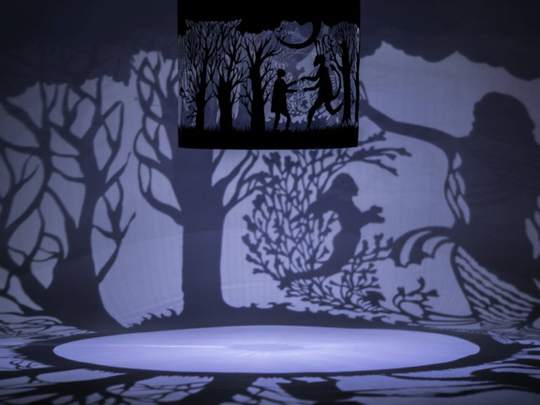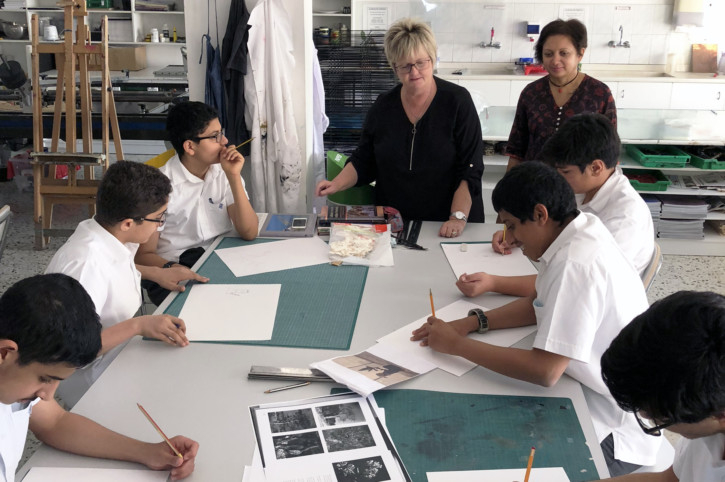
Debjani Bhardwaj’s latest exhibition, Telling Tales, presents traditional Omani and Emirati folk tales through a variety of playful artworks such as intricate papercut dioramas, tunnel books, manually animated videos, an immersive shadow installation and interactive toys like the praxinoscope and Jacob’s ladder.
The Muscat based-Indian artist has always taken inspiration from mythology and folk tales to create two-dimensional papercut artworks that express her dreams and fears. But her participation in the fourth edition of Tashkeel’s Critical Practice Programme has helped her to develop her practice to a new level.
During this year-long programme she focused on researching folk tales from Oman and the UAE and bringing them alive in a new body of work. Her chosen mentors were UK-based art educator Les Bicknell, who specialises in Book Art and Omani artist and curator Hassan Meer, who is the director of Stal Gallery in Muscat. They encouraged her to be playful and experiment with new materials and new ways to present the stories. As part of her research she also visited the Museum of Childhood at the Victoria & Albert Museum in London and has drawn inspiration from old fashioned books and toys exhibited there.
“This programme gave me the opportunity to create work that I had always dreamt of making but was afraid to attempt. The support and critical feedback from my mentors and the substantive budget provided by Tashkeel enabled me to work on a bigger scale and explore the possibilities of creating three-dimensional papercuts and showing movement in my work,” Bhardwaj says.
“Folk tales represent the history, culture and traditions of a society as collectively remembered and told by the people themselves. They speak about the precariousness of the human condition and provide moral guidance, motivation and inspiration through heroic figures, fantastical situations, and supernatural, often anthropomorphic beings such as djinns. Researching Arabian tales was difficult because they are part of the oral tradition of this region but are not easily available in written form. One of my main sources was a book of stories collected and compiled by the students of Zayed University under the guidance of Abdul Aziz Mussalam who is known as the ‘fairy-tale man’ of the UAE,” she adds.
The show introduces visitors to the artist’s favourite stories through recordings of narrations, and her sketches and drawings of various characters and incidents. Bhardwaj has depicted these in her own contemporary style to make them universally relatable, and she has embellished the scenes with accurate, detailed depictions of the landscape, plants, birds and animals of the region.
The stories feature jealous sisters, cruel step mothers and disloyal friends who pay for their crimes and characters such as Hemarat El Ghayla, a half human- half donkey djinn who swallows children that wander out alone in the afternoon; the brave Bedouin shepherdess Selmah who sacrificed her own life to fight and kill a leopard that attacked her goats; and Umm Al Duwais — a jilted woman who transforms into a djinn with a donkey’s legs and a sickle for a hand.
“Many folk tales are cautionary stories designed to discipline children and protect them from dangers such as being dehydrated by wandering outdoors in the afternoon when elders are napping. Others teach moral and social values. The anthropomorphic creatures in these stories remind us of the humanity in animals and bestiality in human beings. Some of the stories are connected to the geography of the land. For instance, the story about Selmah explains the sink holes found in Oman by saying that they were created by meteors that fell from the sky to honour the brave shepherdess. Another story about Salama and her daughters who create tidal waves in the sea explains the long-standing tradition of sailors offering sacrifices of chickens and eggs to ensure safe passage in the dangerous waters of the Strait of Hormuz,” Bhardwaj says.
The artist has arranged her intricate papercuts to create tunnel books and large-scale complex dioramas. For the tunnel books she has arranged several laser-cut sheets of her drawings in layers inside wooden light boxes standing on the floor or suspended from the ceiling to create a narrative and the illusion of depth and perspective. To encourage audience interaction, she has displayed her dioramas behind peep holes located at different heights. Viewers are invited to climb on ladders or kneel on the floor to view the artworks through the holes. “I wanted to recreate the feeling of a view-master, a toy I played with as a child,” she says.
Another work is in the form of the Victorian era toy called a praxinoscope. Here she has lined the moving drum with a sequence of still images of herself playing with the djinn Umm Al Duwais. When the drum is rotated by hand, the images are reflected on mirrors placed inside creating the illusion of movement.
The work titled, Aliens, Tricksters and Shapeshifters, is based on the game ‘Exquisite Corpse’. It is made of wooden blocks and Bhardwaj has hand painted a different djinn on each face. When the blocks are rotated the bodies of the painted figures get realigned creating new hybrid beings.
In an installation titled Lost in a Jinn Forest, Bhardwaj has placed a laser cut Perspex panel around a light to cast shadows on the walls of a room, immersing viewers in a forest inhabited by djinns and other fantastical creatures.
“Shadows are an important part of my papercut works. Like the ephemeral shadows, folk tales also keep changing with every retelling as they are passed down from one generation to another. However, they continue to survive and be relevant because they speak about the human condition and universal human emotions such as greed, jealousy, anger, courage and love. My artworks contain fragments of different stories and I invite viewers to see reflections of themselves in the characters and to read and interpret the stories in their own way,” Bhardwaj says.
The show is accompanied by a programme of talks, tours, film screenings, and workshops for all ages. Information about these is available on tashkeel@tashkeel.org
Jyoti Kalsi is an arts-enthusiast based in Dubai.
Telling Tales will run at Tashkeel, Nad Al Sheba until October 30.














